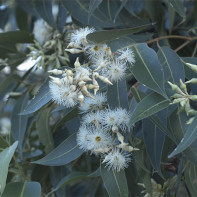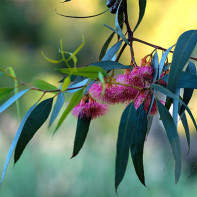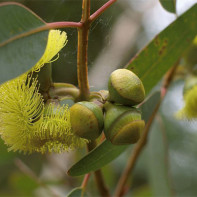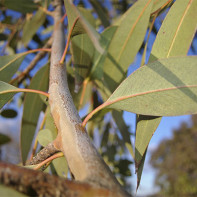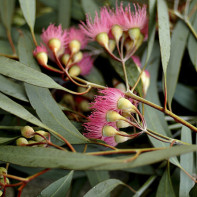Eucalyptus: therapeutic properties and contraindications
The therapeutic properties of eucalyptus is recognized by both official and folk medicine. These evergreen plants belong to the Myrtle family. The genus has more than 700 species, among them there are shrubby species and trees.
- Chemical composition
- What it looks like and where it grows
- Harvesting and storage
- Harvesting
- Drying
- Storage
- Eucalyptus medicinal properties
- For women
- For Men
- In pregnancy
- When breastfeeding
- For kids
- For weight loss
- Eucalyptus in folk medicine
- For diabetes
- For pancreatitis
- For the intestines
- At hemorrhoids
- Cystitis
- For prostatitis
- For coughs
- For colds
- For fever
- For bronchitis
- For pneumonia
- For sore throat
- For maxillary sinusitis
- For immunity
- Kinds of medicinal compositions
- Infusion
- Infusion
- Decoction
- Tea
- Ointment
- Pharmaceuticals based on eucalyptus (drug reviews)
- Chlorophyllipt
- Eucalyptus M, lozenges and tablets
- Pectusin, tablets
- Tincture of eucalyptus alcohol
- Eucalyptus oil: properties and uses
- Cosmetic applications
- Lotion for acne
- Cauterization of pimples
- Rejuvenating Mask for Fading Skin
- Creamy Honey Cheese Mask for Normal Skin
- Baker's yeast mask for oily skin
- Eucalyptus oil for hair
- Easy way to revitalize hair
- Rinse with decoction and infusion
- Tincture to strengthen hair and remove sebum
- Cooking with Eucalyptus
- Culinary infusion recipe
- Exotic Tea
- "Hunting marinade."
- Eucalyptus oil as a seasoning
- Marinade for pork
- How to use eucalyptus broom for a bath
- Contraindications for use
- Interesting facts about eucalyptus
The name of the plant comes from the Greek "eucalyptos", which means "good", "good". The word also has another meaning, "kalyptus", translated as "hide". The European name was invented by French biologist Ch. Brutel in the late 18th century. In Russia, the eucalyptus was called a gum tree or a marvellous tree.
Chemical Composition
The most valuable component of the leaves of the plant is essential oil. In different types of plant material there is from 0.3 to 4.5% of this fragrant substance. 80% of the oil is cineole. The chemical name of the substance is monocyclic terpene (mentane oxide). In its pure form, it is a liquid with a strong, pungent taste, the smell of which is similar to that of camphor. Interestingly, the amount of essential oil decreases slightly after the fresh leaves are dried.
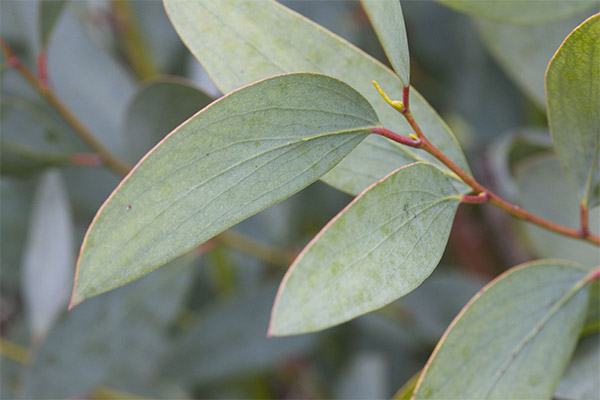
In addition to cineole, the leaves contain tannins, coumaric acid, gallotannins, and cinnamic acid. The raw material is rich in useful trace elements, the leaves contain aromadendren, phytoncides, turpentine oil, phellandrene and vitamins.
The content of the essential component depends on the type of plant. For example, 20 kg of fresh leaves of spherical eucalyptus produces a liter of liquid ether.
What it looks like and where it grows
Representatives of the extensive genus Eucalyptus differ in size, the shape of the leaves, the plants also have common features. Shrubs form tall thickets, and trees grow to a height of up to 100 m. Trees live a long time, there are some known specimens aged 350-400 years.
The trunk of the tree is straight or curved, the crown of different species of eucalyptus is diverse. It can be sprawling, shapeless, pyramidal, ellipsoidal, ovoid, or resemble the crown of a weeping willow. The bark of eucalypts also varies; it can be smooth, fibrous, furrowed, scaly, and folded. Some trees renew the top layer of bark every year.
The leaves of the tree are oriented vertically, edge up. They have a stiff, dry leaf plate and grow on a "twisted" petiole. Therefore, on sunny days there is almost no shade under the tree.
Most species have a strongly elongated leaf plate, but there are eucalypts with rounded leaves. All eucalypts are evergreens and renew their leaves gradually throughout the year. The coloring of the leaves is bluish-green, dark green with a grayish tint.
Eucalyptus trees begin to flower and bear fruit when the tree reaches the age of 2-10 years. Flowering occurs in late spring or early summer. The flowers resemble fluffy balls and the fruits ripen throughout the year. The color of the flowers is white, pink, yellowish, deep red, and bright yellow.
The bolls have a peculiar shape resembling an acorn cut in half, a cone, a pitcher, ribbed spheres, and ellipsoids. The capsule contains several oblong or round seeds. Some species of eucalyptus have wings-like seeds that allow them to move some distance from the mother tree.
Where does it grow
Eucalypts are native to the southernmost and most isolated continent, Australia, as well as the islands lying to the north in the equatorial belt. Most of the eucalypts grow in Australia, while only 15 species are known outside the continent. Only 9 of them are not of Australian origin.
Representatives of this genus grow in the natural forests of the island of Tasmania, as well as in New Zealand. One species grows in the Philippines, several representatives of the genus grow on the islands of New Guinea and in the tropical forests of Indonesia. Above the equator, only one species, the rainbow eucalyptus, grows.
Trees and shrub species breed artificially. The trees grow quickly and are good at drawing water from the soil. Eucalyptus groves are therefore planted in swampy areas in order to drain the soil. This is done in marshy areas in Spain, southern France, Greece, India, Africa, countries of South and North America. Eucalyptus plantations are also found on the Black Sea coast, in Crimea and Abkhazia.
Eucalyptus grows on clay (brown and red) soils, podzolic, chestnut, sandy, peat soils. The plants can be found on plains, in gorges, on mountain slopes, in savannahs, steppes and semi-deserts. On equatorial islands, where forested volcanoes rise, eucalyptus "climb" to a height of 1700-1800 m.
Trees and shrubs prefer wet, but not watered soils, at the same time they well tolerate seasonal floods. But saline and calcareous soils are poorly tolerated by eucalyptus plants. Among them there are thermophilic species that cannot tolerate sub-zero temperatures, and frost-resistant ones that winter at minus 10-14 degrees. Eucalyptus grows in mountainous areas, surviving very severe cold, when temperatures drop to minus 20-24 degrees.
Harvesting and Storage
The collection of eucalyptus leaves is engaged in the inhabitants of the Black Sea coast and Mediterranean countries. Some flower growers grow this plant at home. The bush feels good if there is a lot of light in the house, and the soil is always moist.
As medicinal raw materials are used 3 species of eucalyptus - ash, globular and twig.
Gathering
Recommendations for the timing of collection vary. Some harvesters believe that the leaves should be collected from midsummer to late October. Eucalyptus plantings grown in the Northern Hemisphere contain the maximum amount of essential oil during these months.
Another opinion is that young leaves from the current year are harvested in November, when the temperature drops to plus 10 degrees or lower. Overwintered leaves can be harvested throughout the year. Harvest healthy leaves and young branches up to 40 cm long. It is better to use scissors so as not to cause much damage to the plant.
Harvesting is carried out in clear, dry weather, in the middle of the day. Do not harvest in cloudy weather, early in the morning, in the rain or immediately after. Raw material, supersaturated with moisture, takes longer to dry. With large-scale harvesting, you can miss the formation of mold and rotting green mass.
Drying
To dry outdoors, bundle branches in loose bundles and hang them in the attic, shed, shed or veranda. Brooms are hung so that they don't touch each other. It is important that the greens don't get direct sunlight. Drying in a darkened, well ventilated room is ideal.
If it's raining and the humidity is high, it's better to bring the raw material inside and take it back out when the weather improves. Eucalyptus should be brought home even when the weather is good, as humidity often rises at night in seaside countries.
Raw material harvested as individual leaves can be dried in an oven. The heating temperature should not exceed 100 degrees. Heat the oven, put a tray or rack with the raw material inside, and immediately turn off the heat. Open the oven door ajar a couple of centimeters. Raw stand 1,5-2 hours, then removed from the oven. Repeat the procedure until the leaf is dry and brittle.
Drying in the oven is better replaced by natural drying or processing in a fruit dryer. At temperatures above 40 degrees, the essential component evaporates greatly.
Eucalyptus can also be dried in an electric fruit and vegetable dryer. Pour the leaves on plates, close the device and set the heating temperature to 35 degrees. Every 15 minutes change places between the bottom and top trays so that the raw material dries evenly. At the end of drying, turn off the device and allow to cool, only then take out the dried eucalyptus.
Storage
Dried raw material in bundles can be left for storage in the same form in which it was collected. Brooms of eucalyptus twigs are hung on the wall in a dry, ventilated pantry or in a shed. The branches and leaves can be crushed and stored in small bags of burlap or other porous cloth.
The same way to pack a leaf dried in an oven or electric dryer. Cardboard boxes with holes can be used instead of sacks, but not plastic bags and containers. In metal vessels, glass jars eucalyptus raw material is stored for a short time.
Harvest can not be placed in the cellar, basement, any other place with high humidity. In the apartment stock is stored in a bag or jar, on a closed shelf, away from food. Shelf life of blanks not more than 2 years.
Therapeutic properties of eucalyptus
Preparations made from dried leafy raw materials have the following types of action.
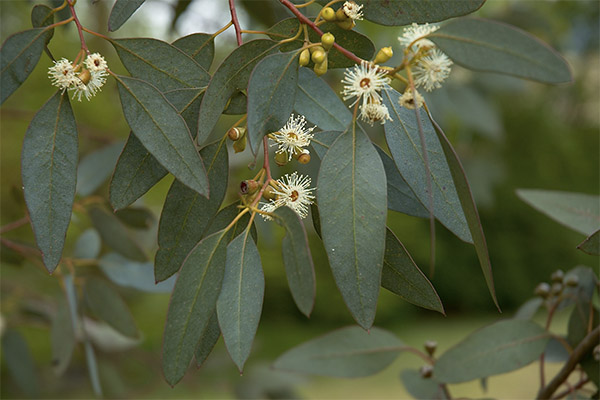
- Antiseptic and bactericidal. Organic hydrocarbons aromadendren and fellandren in contact with oxygen molecules form ozone (O3). It destroys many pathogenic bacteria inside the body and on the skin, including mutated forms resistant to antibiotics.
- Antiparasitic action. Eucalyptus can kill helminths and is used to expel parasites, effective against adults and eggs.
- Soothing and analgesic effect, including in pain caused by spasms.
- Substances in eucalyptus normalize the production of insulin by the pancreas, which helps reduce blood sugar.
For women
Infusions of dry raw materials are successfully used in the treatment of cervical erosion, endometriosis and endometritis. Infusions are taken internally and used externally as an antiseptic and healing agent. Tampons are moistened with a therapeutic solution and inserted (put) inside the vagina.
Means on the basis of eucalyptus are effective for treating cystitis and pyelonephritis. And the infusion wipe the skin to quickly get rid of facial pigmentation after childbirth.
For Men
The antimicrobial properties of eucalyptus allow the use of infusions from this plant for inflammatory and chronic diseases of the male genital organs. This is acute and chronic prostatitis, other pathologies caused by pathogenic bacteria.
In pregnancy
Official medicine has no data on the benefits and harm of eucalyptus oil and medicinal drinks on the body of the future mother. On packages with herbal raw materials, manufacturers indicate that the use of preparations is not recommended for future mothers. It is better to consult a gynecologist on this issue.
When breastfeeding.
Manufacturers of raw materials do not recommend eucalyptus compositions and oils to nursing mothers. This is because the effects of the esters and other active substances on a woman's milk and baby have not been adequately studied.
It is not studied which substances can penetrate into the woman's milk. Therefore, during breastfeeding, it is better to refuse preparations based on eucalyptus.
For children
Children under 2 years of age are not prescribed medicines from eucalyptus. This applies not only to the adoption of drugs internally, but also for external use. For children over 2 years old, the use of drugs is possible only in the absence of allergic reactions. When preparing infusions and remedies inside should be guided by the recommendations of manufacturers of raw materials and drugs.
When losing weight
People who want to lose weight and suffer from hunger will help eucalyptus oil. The sharp smell of ether suppresses the irresistible desire to eat something. It is the feeling of hunger that is the reason for refusal of a diet, breakdowns, after which extra pounds come back. The scent of eucalyptus oil helps suppress "psychological hunger", when rumbling in the stomach occurs at the sight of a beautiful cake, puffy buns and ice cream. If you inhale the smell of the essence before a meal, the appetite will decrease, and the person will not overeat.
Eucalyptus in folk medicine
Folk healers treat with preparations from eucalyptus a variety of diseases. The plant contains substances that destroy dysentery and typhoid bacilli, streptococci, staphylococci, trichomonas and other pathogens.
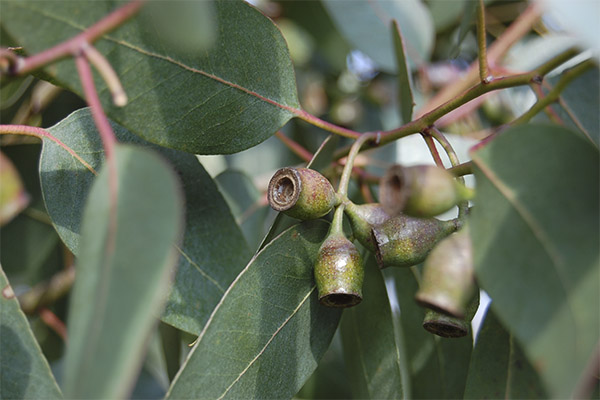
Eucalyptus is effective in the treatment of any inflammatory processes, pyelonephritis, urethritis, other diseases of the genitourinary tract, as well as herpes. Folk healers believe that herbal remedies also act on viruses, activate the immune system and help recover from flu and respiratory viral infections. If you use preparations based on eucalyptus raw materials, you can reduce the likelihood of viral diseases.
External remedies are effective for psoriasis, eczema, dermatitis of various genesis. These preparations treat poorly healing ulcers and bedsores. Decoctions wipe the skin, make applications and compresses.
Infusions soothe the skin after nettle burns, insect bites, including mosquitoes, midges, mosquitoes, fleas and bedbugs. Strong infusion of eucalyptus leaves can be recommended for rubbing the scalp with pediculosis, eucalyptus oil - for the prevention of lice infestation. In public places, where there is a risk of contact with insects, fragrant oil is dripped on the head.
Compressions from the infusion of eucalyptus - an effective analgesic and anti-inflammatory agent for joint pain, arthritis, lumbago, arthritis, rheumatism, neuralgia and osteochondrosis.
Means on the basis of this healing plant is used externally and internally. Internally, they prepare infusions, tinctures, decoctions, oils, teas. As external preparations use infusions, oils, ointments, powdered leaves, decoctions.
When diabetics.
Eucalyptus oil is a natural product that helps reduce sugar levels in diabetes. There are several recipes for using this product from folk healers and patients.
- A piece of black bread is kneaded to a crumb and rolled into a small tortilla. Drip 3 drops of sunflower oil and 1-2 drops of eucalyptus oil on the crumb. Eat the cake and drink water with lemon juice.
- Pour 20-30 ml of milk in a shot glass, drop 1 drop of geranium and eucalyptus oil in it and drink. The remedy is used twice a day, in the morning after a meal and in the evening before dinner.
In pancreatitis
Eucalyptus has a positive therapeutic effect in pancreatitis. It is used in the treatment with vegetable oils and fats.
In a teaspoon of vegetable oil add 1 drop of peppermint and eucalyptus oils. In the morning, on an empty stomach, take the oil in your mouth, but do not swallow it, and slowly, taking your time, suck it up for 15-20 minutes. Instead of mint, you can take juniper, lavender, ginger, mandarin oil.
To normalize the work of the pancreas, use complex gatherings, which can be prepared by yourself. They include a large number of plants. An example of a collection:
- crushed eucalyptus leaf;
- immortelle;
- tansy;
- bearberry;
- flowers of chamomile;
- sweet clover;
- calamus root;
- linseed;
- corn stigmas;
- St. John's wort;
- marshmallow;
- flowers of linden;
- rose hips;
- elecampane;
- lingonberry leaf.
All kinds of herbal raw materials are taken in equal amounts. A teaspoon of the collection boiled (400 ml), cover and insist until the liquid is warm. The infusion is drunk twice a day, a full glass.
For the intestines
Decoction of dried raw materials helps with spasms and pain in the intestines. This drink is also drunk in chronic gastritis associated with reduced acidity.
On scales measure 25 grams of chopped leaves, pour the raw material into a liter jar and boiled water (0.5 liters). Then put in a boiling water bath and incubated for 15 minutes. Then remove the pot, cool 40-50 minutes and strain. If the water boiled out, add water to bring the volume of broth to 0.5 liters. Means drink three times a day, 2-3 tablespoons.
Hemorrhoids
enemas from fresh eucalyptus soothe pain and reduce inflammation in hemorrhoids. 300 g finely chopped leaves, pour 1 liter of water and bring the liquid to a boil. Then remove the pot from the stove, put it on a thick towel and wrap it on all sides.
Keep the vessel in heat for 30-35 minutes, then strain the decoction. Put warm enemas, using a small balloon. If hemorrhoid cones are not erect, make external compresses of the same infusion.
With cystitis
Cystitis is better treated with antibiotics. As an additional procedure make a sitting bath with healing oils. In 15 liters of warm water (bath volume) add 5-7 drops each of eucalyptus, sandalwood and lavender oil. The duration of the procedure is 15-20 minutes, you can take a bath twice a day.
Folk healers recommend taking sitting baths with herbal decoctions based on a collection of 5 components. The mixture includes dried raw materials:
- Eucalyptus leaf - 1 spoon;
- Calendula (flowers) - 6 spoons;
- St. John's wort, horsetail, chamomile - 5 spoons each.
Raw materials are mixed, steamed with any amount of water, bring to a boil and cool. Then poured into a prepared sitting bath with warm water (38-40 degrees). The duration of the procedure - 15-20 minutes, you can take a bath twice a day until the symptoms of the disease disappear.
With prostatitis
With chronic prostatitis do general and sitting baths with infusions and oils. In a large bath add decoctions of chamomile, thyme, other herbs with anti-inflammatory and soothing effects. Decoctions are prepared according to instructions from manufacturers of medicinal herbs.
Also add rosemary, cypress, eucalyptus oil (3-4 drops each) to the water. Essential oils of patchouli, sea buckthorn, coniferous trees (3 drops each) have a good effect.
A good anti-inflammatory agent for acute prostatitis is an enema. To prepare the solution, 3 drops of eucalyptus oil are added to 30 ml of milk. For the procedure, take a small rubber balloon with a soft tip.
For coughs
When coughing, a tea of dried leaves is prepared. 3 tablespoons of crushed eucalyptus brewed with boiling water (250-300 ml). Infuse for 25 minutes and strain through several layers of gauze. Tea is drunk during the day in small sips.
Each day a new tea brewed. This expectorant can be drunk with bronchitis and complications of respiratory diseases.
For runny nose.
Nasal flushing cleanses the sinuses and destroys pathogens on the mucous membranes, relieves swelling and inflammation. To prepare the solution in warm water (0.5 l) dissolve a teaspoon of sea salt and add 4 drops of eucalyptus oil. Draw the liquid into a rubber enema and flush the nose, keeping your head upright.
With a runny nose is useful to inhale the smell of the ether. Eucalyptus oil is dripped on cotton pads and put them in the bedroom. It is also useful to make inhalations with a runny nose. A few drops of eucalyptus oil are added to a saucepan with hot water. Cover your head with a towel and breathe the water and ether vapor through your nose.
For inhalations also use a nebulizer - a handy device, especially when it comes to treating a child. In a container, pour 30 ml of warm boiled water or saline solution. Add 2-3 drops of eucalyptus oil and inhale for 6-10 minutes. It is recommended to close the eyes so that the ether does not irritate the mucous membranes.
The runny nose also helps ointment, which is not difficult to make yourself. In a jar from the cream or in a small container put a spoonful of petroleum jelly and add oils - eucalyptus (5 drops), tea tree (5 drops), mint (2-3 drops). The ingredients are mixed well. Lubricate the skin over the nasal sinuses, renewing the ointment 2-3 times a day. Means can be stored for several days, closing the jar with an airtight lid.
At a fever
In case of fever, rub the oil-water emulsion. Add 4-5 drops of eucalyptus oil to 50 ml of water and rub the solution into the chest and back. After a few minutes the temperature will begin to decrease. If necessary, the procedure is repeated.
For bronchitis
Inhalations are used to treat bronchitis. For hot inhalation, 10-15 drops of oil are added to just boiling water and the steam is inhaled by leaning over the pot. Your head is covered with a towel. Breathe through the mouth and nose. For a speedy recovery the procedure should be carried out 1-2 times a day.
Instead of oil you can use a hot infusion. To do this, 20 grams of crushed eucalyptus leaf is boiled and allowed to infuse for 15 minutes. Inhalation is carried out in the same way as when using oil. The duration of the procedure is 6-10 minutes. You can do cold inhalation. To do this, drop the oil on a napkin, deeply inhale the ether.
When pneumonia
When treating pneumonia, it is useful to massage the chest with a mixture of eucalyptus and sunflower oil. Olive oil can also be used.
Combine 3-4 drops of eucalyptus oil with base oil and whisk well. The remedy is rubbed into the chest and back.
After consulting a doctor, you can do eucalyptus inhalation as in bronchitis.
With sore throat
With a sore throat and sore throat 10-15 drops of oil dissolved in a glass of boiled warm water. The resulting solution is gargled throat every 2-3 hours.
You can make a gargle infusion based on dried pharmacy raw materials. 2 tablespoons of crushed eucalyptus pour a glass of boiling water, infuse 2 hours and strain. Gargle the throat 5-6 times a day.
With maxillary sinusitis.
In the treatment of maxillary sinusitis, 2 spoonfuls of dried eucalyptus leaves are placed in a humidifier. You can also drop a few drops of oil on a absorbent cotton and put it in the room.
When treating maxillary sinusitis, it is useful to do inhalations over steam. Two drops each of ginger and eucalyptus oil are added to water that has just boiled. Also add 1-2 drops each of thyme and tea tree oils. Inhalation is performed with your head bent over the pot and covered with a towel. The duration of the procedure is 7-10 minutes.
For immunity
To improve the immunity, it is recommended to inhale the aroma of eucalyptus ether. In stores that sell goods for aromatherapy, they sell small canvas bags with dried herbs, leaves, flowers, which are called sachets. You can make such a healing bag with your own hands, putting it in the eucalyptus leaves.
The smell of essential oil is especially useful to inhale in the winter, when there is a high probability of flu and acute respiratory infections, and the premises are poorly ventilated. To improve immunity, it is useful to drink tea with eucalyptus leaves and do aroma massage with essential oil.
Types of medicinal compositions
On the basis of eucalyptus folk healers make infusions, tinctures, decoctions, teas, ointments and oils. Mostly dry raw materials are used, but there are recipes for preparations from fresh leaves.
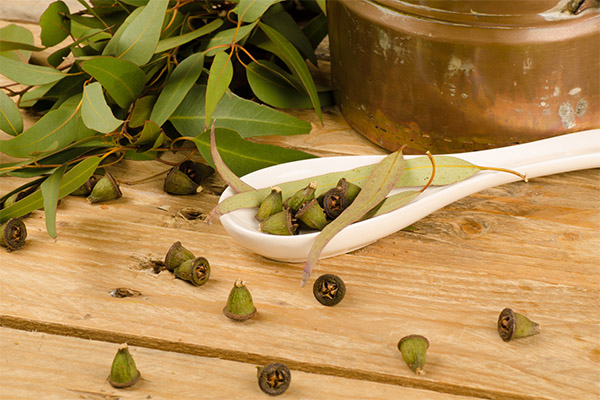
Infusion
Therapeutic infusions are made from dry leaves, the raw material is prepared independently or bought in the pharmacy. To prepare a therapeutic agent, the raw material is poured into an enamel or ceramic container, brewed with hot water and put in a hot water bath. The liquid in a large saucepan (bath) is heated to boiling and kept in this mode for a specified time.
In some recipes, it is only enough to bring the bath to a boil, in others the infusion is heated for several minutes. After this, the small pot is removed from the bath and cooled, and the raw material is strained and squeezed.
Many folk recipes do not use a water bath, they heat the pan with the raw material and water directly on the stove, and after boiling, they cool it.
Tincture
Tincture of eucalyptus raw materials is used for ingestion and external procedures, as well as for rubbing. The composition of homemade remedy is identical to that of a similar drug produced by pharmacological companies.
To prepare a remedy you need ethyl alcohol (0.5 l) and dry leaf Eucalyptus twigs (100-120 g). Raw material is placed in a glass jar, pour medical alcohol (70%) or good vodka. Hermetically sealed and insist 2-3 weeks without access to sunlight. Then the plant cake is removed, the alcohol is filtered. Tincture is stored in a tightly closed container in the refrigerator.
Decoction .
Decoction is prepared by the same technology as the infusion in a water bath. But the plant raw materials are boiled longer - from 10 to 30 minutes or more. This method for preparing remedies from eucalyptus is not often used, because boiling evaporates essential component and the product loses its healing properties
For the preparation of medicines use not only the leaf, but also the eucalyptus bark. This raw material contains much less essential oil. But it has a lot of tannins - 40% more than the leaves.
Bark is used in folk medicine of many peoples around the world. The astringent substances, tannins have a firming effect on the intestines for diarrhea.
Tea
Eucalyptus medicinal tea is made by brewing crushed dry leaf. This is done in a thick-walled cup or mug of large volume. Per serving of the drink (200-250 ml) take 0.5-1 teaspoon of dry plant.
Tea infused for 3-5 minutes and drink it hot. This drink is used as a preventive, restorative and tonic.
Ointment .
The basis of home made ointments can be petroleum jelly or greasy cream, sunflower or olive oil. The base is injected into the healing substances. In addition to eucalyptus oil, you can add several other types with a similar effect - myrtle, lavender, peach, sea buckthorn, ginger and others.
Pharmaceuticals based on eucalyptus (drug review)
The pharmaceutical industry produces a large assortment of drugs that include raw materials and extracts of eucalyptus leaves. These drugs are sold without a prescription.
Chlorophyllipt
On the basis of the extract of eucalyptus globularis produce drugs of the group Chlorophyllipt.
Medicines are available in the following forms:
- oil solution for topical application;
- lozenges for resorption;
- alcoholic infusion.
The active ingredient of the drugs is an extract of eucalyptus globular leaves.
Chlorophyllipt oil solution contains 2% eucalyptus extract, is used to treat cervical erosion. The drug is used by wetting cotton swabs in the oil and introducing them into the vagina. The drug lubricates the cervix and eroded areas.
Resorption tablets contain 0.25 ml of eucalyptus extract. It is prescribed as an antibacterial drug for diseases caused by staphylococci, as well as a disinfectant for staphylococcal carriage, infections by bacteria resistant to antibiotics, treatment of poorly healing wounds.
Some types of tablet drug contain additives - ascorbic acid and echinacea extract.
Alcoholic tincture of Chlorophyllipt contains 1% eucalyptus extract. The drug is intended for oral administration, it is also prescribed as a remedy against staphylococcus and antibiotic-resistant microorganisms. The drug has an anti-inflammatory effect. The drug is not prescribed to patients under 18 years of age.
Eucalyptus M, lozenges and tablets for sucking
Eucalyptus twig oil and levomenthol are used to produce the drug. Menthol has a "cooling", antiseptic effect, eucalyptus extract destroys pathogens in the mouth and throat, and has an anti-inflammatory effect. The product reduces cough and sore throat. The drug is effective for pharyngitis and tracheitis. The lozenges can be used to soften the vocal cords before long speeches in front of an audience.
Pectusin, tablets
The active ingredients of the drug are the oil of eucalyptus twig leaf and levomenthol (racementol). The drug acts in the same way as Eucalyptus M, having antimicrobial, antiseptic and anti-inflammatory effects. Pectusin is prescribed orally for pharyngitis, bronchitis, angina, laryngitis. The tablets are placed on the tongue and held until dissolved.
Tincture of eucalyptus alcohol
Tincture is a greenish brown liquid with the smell of alcohol and eucalyptus ester. The extractant of the drug is ethyl alcohol (70%). The solution is prepared by infusion of 200 g of dry Eucalyptus twig leaves in 1 liter of ethanol.
To prevent the essential component from decomposition by sunlight, the tincture is produced in dark glass bottles packed in a cardboard case. The drug is used for steam inhalations, baths, preparation of ointments and cosmetics. Inhalation is not done in children under 3 years.
Eucalyptus oil: properties and uses
Eucalyptus leaf oil has the same useful properties as other means - infusions, tinctures and decoctions. The advantage of the product is a high concentration of ester, organic acids, other substances and elements.
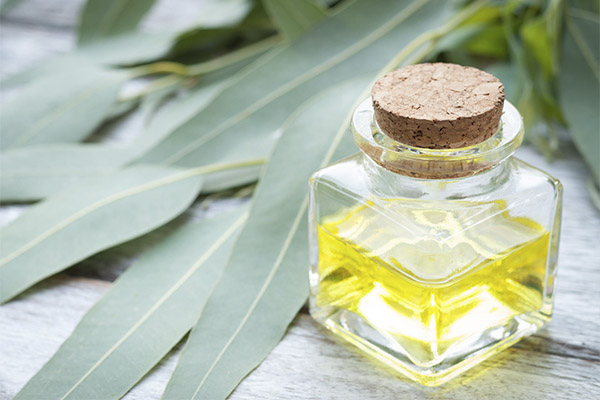
The properties of eucalyptus oil are associated with a large set of useful substances and their combination. The product:
- Has a bactericidal, antiseptic effect, destroying pathogens.
- Acts as an analgesic, including in spasms of different origin.
- It has a sedative effect.
- Kills worms (worms and pinworms) in the intestines.
Due to numerous therapeutic properties, the ether is successfully used in the treatment of gynecological diseases, burns, acne, rheumatism, arthritis and other pathologies accompanied by pain in the joints, used as an antipyretic. Infusions and decoctions are effective preparations for inhalation for bronchitis and cold cough. Vapors destroy bacteria in the room. Therefore, inhaling the smell of the ether is recommended for those who are sick and do not want to infect others.
Cosmetic uses
Home and drugstore preparations on eucalyptus are actively used in home cosmetology. They are used to care for problem skin and hair.
Lotion for the treatment of acne
This lotion is good for drying oily skin and acne. To prepare the product you need eucalyptus oil. Also need tea tree oil, fresh lemon juice (2 tablespoons), grape seed oil.
Squeeze the juice of the lemon into a small cup and strain it through several layers of gauze (or through a cloth). The procedure is repeated until no flakes and particles of film covering the slices remain in the juice. Using a pipette, add 2 drops of each type of oil.
The lotion is used twice a day. The first time, the skin is rubbed in the morning, after washing. After 10-15 minutes, if you feel tightness of the skin, the composition is washed off with cool water. The procedure is repeated in the evening, before going to bed.
Cauterization of pimples
Eucalyptus oil is used for spot treatment of pimples. A cotton swab is dipped in the oil and applied to the pimple. It is not necessary to smear the entire skin with the product, the oil is applied spotwise, only on the head of the pimple. Under the influence of the ether, the pimples will quickly dry out and disappear.
Rejuvenating mask for aging skin
In a small cup, break a chicken egg, remove the white and leave the yolk. Add half a teaspoon of eucalyptus oil and the same amount of castor oil. The mixture is thoroughly whipped and applied to the face in an even layer. The mask is held for 6-8 minutes, then washed off with room temperature water.
The yolk tones the fading skin and the oils soften the skin well. The eucalyptus extract nourishes the skin with organic acids and trace elements.
Cotton and honey mask for normal skin
This type of mask soothes and nourishes skin with normal oiliness. In a small container, mix honey, fresh cottage cheese, kneaded into a smooth paste, and infusion of eucalyptus. Take the ingredients in equal quantities and mix well. The mask is put on the face and rest for 20 minutes. Then the curd and honey mixture is washed with room temperature water.
Baker's yeast mask for oily skin
Dilute a packet of yeast with warm decoction of eucalyptus (to the consistency of sour cream) and add a spoonful of non-fat kefir to the paste. The mask is applied in a thick layer and kept until it dries, when the skin begins to feel tight. The paste is washed off with cool or lukewarm water.
Instead of yeast, you can use rye bread soaked in decoction of eucalyptus. This mask does not create a strong tightening effect.
Eucalyptus oil for hair
This herbal remedy is used to restore hair damaged by daily "care" - styling with a hair dryer, curling on curlers, coloring and other hairdressing procedures. The oil effectively eliminates dandruff, reduces the oiliness of the scalp, the main reason for oily hair, soaks up split ends, but does not weigh the hair. The product gives your hair back its shine, flexibility and healthy look.
This product is also useful for hair loss. Organic acids, aldehydes, flavonoids and ester nourish the hair follicles, as a result hair loss stops, hair follicles begin to revive.
You can buy the oil in the drugstore or make your own from the individual ingredients. The therapeutic procedure is carried out in the following order.
- The hair is washed with shampoo, dried and combed with a massage brush.
- Drip a few drops of oil on a comb with fine teeth and apply the product to the hair, running the comb from root to tip. Then again, apply the oil to the comb and comb through all the strands, all the way through.
- Hair is twisted and a towel in the form of a turban is put on the head.
- Oil mask is held for 30 minutes and washed with shampoo. Hair is recommended to dry naturally.
A simple way to revitalize the hair.
In a bowl put a small amount of shampoo, necessary for washing the head. Then add 4-5 drops of eucalyptus oil to the bowl and mix it with the shampoo. After that, wash your head. Shampoo with eucalyptus is an effective tool for nourishing the hair and revitalizing the roots.
Rinsing with decoction and infusion
Eucalyptus rinses are done after shampooing, once a week. If the procedure is carried out regularly, the hair becomes silky, supple and flexible. Decoctions should be prepared immediately before bathing procedures.
Tincture to strengthen the hair and remove sebum
This remedy is prepared on an alcohol basis. In a liter jar, put the dry raw material of eucalyptus (2-3 tablespoons) and a spoonful of sugar. The jar is closed and the liquid infused for five days, without access to sunlight. Then strain the tincture, pour into a bottle, seal the vessel and place in the refrigerator.
Once a week, treat the scalp by dipping a cotton swab in the tincture. After half an hour, wash it off.
How to use eucalyptus in cooking
The sharp, bitter taste of eucalyptus leaves, the strong smell of essential oil allows you to use this plant as an exotic spice.
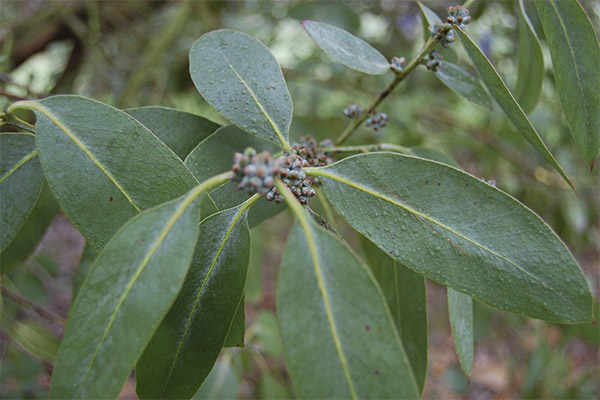
Recipe for culinary infusion
You can prepare your own infusion and add it in small quantities to a variety of dishes. 2 tablespoons of dried crushed leaves are brewed with a glass of boiling water, let cool and strain. The spice is ready.
Sprinkle a small amount of the infusion on meat and fish during frying, add a spoonful of liquid to stews. To ensure that the essential oil does not evaporate completely, the spice is added to products a few minutes before the end of heat treatment.
Exotic Tea
To prepare the drink, you need a large teapot. In the vessel put a few slices of lime, 1-2 dried leaves of eucalyptus, a sprig of rooibos (rooibos). Infused with boiling water and cover. The drink is not stored, it is prepared before consumption, the number of participants in the tea party.
"Hunter's marinade".
"Hunting marinade" is called the branches of odorous plants, which are placed on the coals or grill grates when roasting meat and large river fish. These are primarily plants that contain esters and resinous substances - eucalyptus, juniper, laurel, rosemary, black pepper and allspice (pea). It is better to limit the amount of eucalyptus to a couple of leaves, as essential oils evaporate intensely on hot coals, and the food will take on an excessive smell and bitterness.
Eucalyptus oil as a condiment
1-2 drops of eucalyptus oil can be added to a sauce made for roasted lamb, wild poultry and other meats. The smell of the essential is quite compatible with the smell and taste of garlic, coriander, and honey.
The same amount of eucalyptus oil is added to brown sugar, honey-based sweet desserts, fruit sauces, vinegar, jam and jam.
Pork marinade.
2 crushed eucalyptus leaves are infused with 1 liter of boiling water. While the infusion cools, in a ceramic, plastic or enamel pan lay pieces of meat. In a eucalyptus solution put an onion, chopped rings, slices of carrot, salt and black pepper (peas). Then pour half a shot of wine vinegar. Pour the marinade over the pork and put it in the fridge for 5-7 hours.
How to steep a eucalyptus broom for the bath
Lovers of hot steam appreciate the aroma of essential oil that fills the steam room. Dry eucalyptus leaves are not as tough and brittle as other species. Therefore steamed broom in a special way.
In a wooden tub they pour boiling water and immerse the broom for 15-20 minutes. In 5 minutes a leaf changes color and turns deep green. When the leaves soften a little, take out the brooms and dip them with the handle into the water so that the hot moisture goes into the branches. This is done if the tub is narrow. If the tub is wide then the brooms are immersed as a whole.
After 20 minutes the broom becomes soft, all leaves and branches - flexible and elastic. Twigs and leaves bend well and do not break. Water that remains after steaming is saturated with essential oil. If it is splashed on the stove, the aromatic smell of eucalyptus will stand in the entire steam room. The steamed broom is placed on the face and the smell is inhaled, thus making steam inhalation.
The disadvantages of steamed eucalyptus broom include excessive flexibility. You need to get used to steaming with flexible twigs with long leaves.
Some bath lovers make brooms from different kinds of wood, focusing on the smell that will emit steamed "bouquet". Eucalyptus is combined with birch, oak and juniper.
Contraindications for use
Preparations based on eucalyptus raw materials can not be used if you are allergic to this product. The ban applies not only to therapeutic means, but also to cosmetology and cooking. Allergic reactions when applied externally appear in the form of rash, redness, itching, general malaise. When used internally, nausea, vomiting, dizziness, skin rash and redness, swelling may occur.
Eucalyptus leaf and oil are contraindicated for inhalation in whooping cough, bronchospasm and bronchial asthma. These remedies are not intended to treat children under 24 months of age.
Treatment with eucalyptus is not allowed for people undergoing chemotherapy, those who have been diagnosed with epilepsy, severe kidney disease, liver disease, often high blood pressure.
Although medicines based on eucalyptus refers to homeopathic medicines, they can not be combined with other drugs. There are no proven data on their interaction with essential oil and other active ingredients.
Interesting facts about eucalyptus

- The leaves of the eucalyptus can be used to determine the sides of the world. In Australia, the plane of the long leaf extends parallel to the meridian, and the planes of the leaf plate "look" to the east and west.
- Biologists claim that some Australian eucalypts can be up to 8-9 thousand years old.
- Eucalyptus bark contains twice as many tannins as oak bark.
- In Australia, in the Gippslend region, on Mount Bau-Bau, one of the world's tallest eucalypts grows. It is 99.4 meters tall.
- Another giant eucalypt grew on the island of Tasmania, near the course of the Styx River. The height of the tree is 98.1 m. The giants are estimated to be 350-400 years old.
- Eucalyptus seeds are adapted to survive in the harsh Australian conditions. They keep germinating up to 9-10 years, but the seeds were known to stay germinating even after 40-50 years.
- Many species of eucalyptus, when the trunk is damaged, secrete red gum, which is used in medicine, cooking and industry. To extract this substance, incisions are made on the trunk of the tree, as when collecting birch sap. Gum is called kino (with the stress on the first syllable). This word is of Indian origin. The gum that emerges resembles red currant jelly, but after a few hours it dries out and looks like red amber. The main active ingredient in gum is the astringent tannin compound, cinotannic acid. Gum has a searing taste and is marketed under the common name "Australian kino".
- Kino was used as a drug to stop diarrhea. This substance does not dissolve and is not absorbed in the stomach, interacting only in the lower intestine.
- Crushed gum was added to a mixture of glycerin, alcohol and water and used as a gargle for sore throats. The Aborigines of Australia add kino powder to tea when treating colds. Such eucalyptus groves, in which the trunks of the trees secrete gum, are called "blood forests" in Australia.
- In India this substance was used to dye cotton cloth yellowish-brown.
- The leaves of the twig eucalyptus produce a mucus-like effusion during the winter season. This substance tastes like glucose or fructose. Australian Aboriginal and Maori people collect it and use it as a sweet treat. This substance is known as New Zealand manna or Australian manna.
- Another type of manna, perp, appears on the leaves of the Manon Eucalyptus, as well as dumosa and resinifera species growing in Tasmania and southern Australia. This type of secretion appears as a result of insects puncturing the leaf plate.
- In Italy, a liqueur is made from eucalyptus leaves. The drink is considered medicinal and is drunk to prevent and treat fevers (intermittent fever).
«Important: All information on this site is provided for informational purposes only purposes. Before applying any recommendations, consult a specialist. should be consulted with a healthcare professional before any recommendations are used. Neither the editors nor the authors shall be liable for any possible harm caused by materials."

